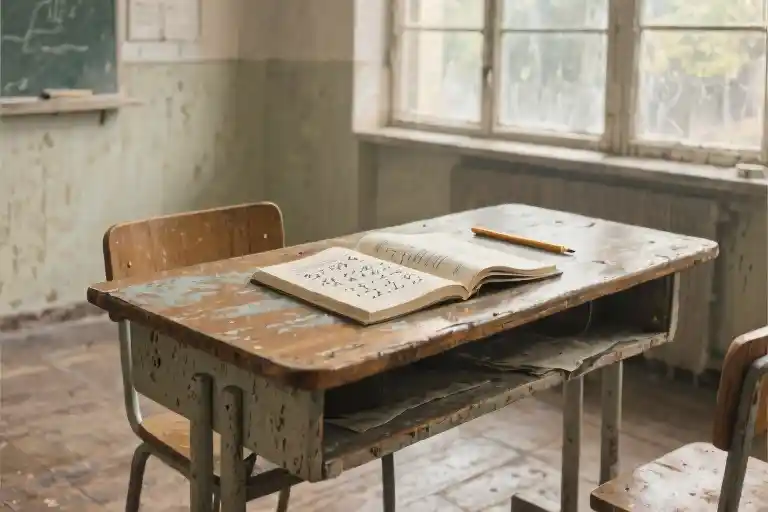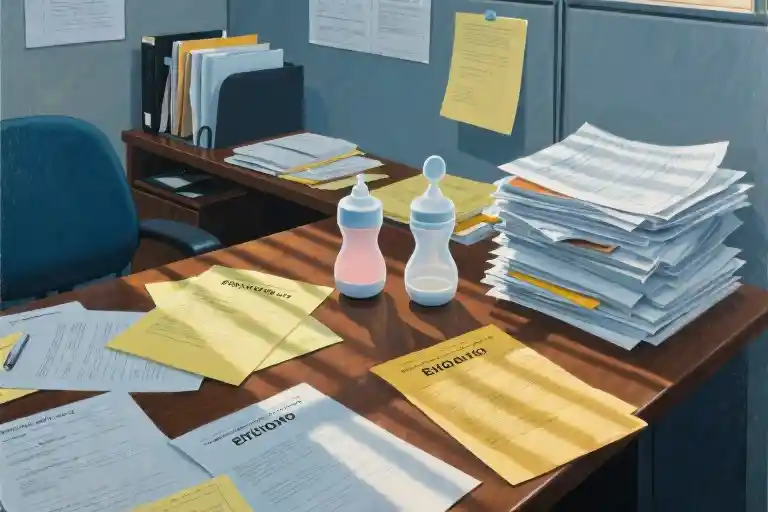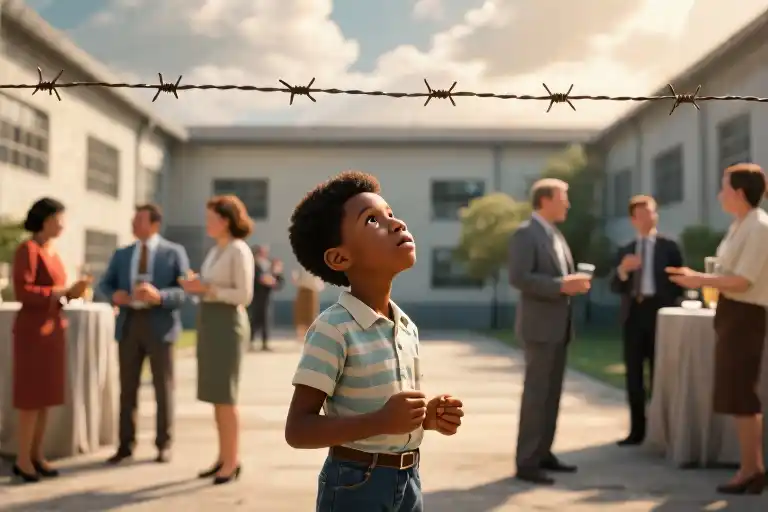The morning Steven Gray disappeared smelled of cut grass and diesel fumes. I remember because we were sharing a seat on the school bus, his bony elbow digging into my side as he leaned over to point at a coyote carcass by the roadside. His last words to me were about how its fur still looked soft in the morning light. By afternoon recess, his desk sat empty with a half-finished arithmetic worksheet, the pencil groove still warm from his fingers.
At Armentrout’s General Store & Mercantile that evening, Mr. Armentrout was tacking up notices about next week’s livestock auction when I asked if he’d heard about Steven. He paused just long enough to adjust his suspenders before saying, ‘Ain’t my business to mind other folks’ young’uns.’ The bulletin board held twelve neatly pinned papers – water rights disputes, sawmill job listings, even a lost dog notice with a $5 reward – but nothing about a missing twelve-year-old boy. Not even the crooked thumbtack hole where such an announcement might have hung.
The school principal’s reaction was worse. When Mrs. Holloway marked Steven absent for the third straight day, she simply drew a line through his name in the ledger and muttered about ‘transient families.’ Never mind that the Grays had lived in that tarpaper shack longer than the schoolhouse had stood. Never mind that Steven’s lunch pail still sat in the cloakroom, the bologna sandwich inside turning green at the edges.
What stays with me isn’t the disappearance itself – on Indian land, people vanished like morning fog over the Weyerhaeuser timberlands. It’s the particular quality of silence that followed. No sheriff’s deputies knocking on trailer doors. No volunteers combing the blackberry thickets along the river. Just the ordinary sounds of a poor community moving through its days – screen doors slamming, pickup trucks backfiring, mothers calling children home to supper – with one less voice in the chorus.
Years later, I’d learn this phenomenon had a clinical name: ‘missing white woman syndrome.’ But in 1978, in that patchwork community of loggers’ kids and migrant workers’ children, we only knew that some disappearances mattered more than others. The unspoken calculus had nothing to do with milk cartons or amber alerts, everything to do with whose parents could afford to make noise, and who had the right complexion for protection.
The Boy Who Wasn’t There
The school bus smelled of wet wool and pencil shavings that afternoon. Steven Gray sat two rows ahead of me, his pale neck visible between the frayed collar of his hand-me-down flannel and the uneven haircut his father probably gave him. He was drawing dinosaurs in the fogged window glass with one finger, the way poor kids learn to entertain themselves. That’s the last reliable memory anyone seems to have of him.
Steven’s family occupied that peculiar social stratum – white but impoverished, living on leased land within the reservation boundaries. His father worked sporadic shifts at the Weyerhaeuser sawmill when they’d hire him, his mother took in laundry from the few families who could afford such luxuries. Their trailer sat at the end of a mud road even the school bus refused to navigate in springtime, which meant Steven walked nearly a mile to the stop in all weather. These details matter because poverty writes its own rules about what constitutes a disappearance worth noticing.
Mrs. Calloway, our bus driver for seven years, swore she dropped Steven at his usual stop that Tuesday. Old Man Jenkins claimed he saw a boy matching Steven’s description cutting through the timber company’s land around dusk – but then again, Jenkins also swore he’d seen Bigfoot behind the Armentrout’s store last fall. The sheriff’s office took exactly one statement from Steven’s mother before closing the case file. No dogs were brought in, no helicopters circled, no volunteers formed search parties. Just another working-poor kid gone missing on Indian land – hardly front page material.
What’s chilling isn’t the disappearance itself, but how perfectly it mirrored other cases depending on who went missing. When Maria Hernandez vanished two years prior, the Mexican consulate got involved within 48 hours. After Jamal Carter stopped coming to school, the NAACP sent observers to monitor the investigation. But white trash disappearing on reservation land? That fell into some bureaucratic crack between jurisdictions, a no-man’s land of accountability. The tribal police said it was a county matter. The county sheriff muttered about ‘sovereignty issues.’ Meanwhile, Steven’s desk gathered dust until Christmas break, when someone finally removed his name tag.
There’s an unspoken hierarchy even among the disappeared. The milk carton campaigns, the amber alerts, the breathless cable news coverage – these mechanisms activate selectively, calibrated to some invisible calculus of newsworthiness. Steven Gray didn’t fit the algorithm. Not tragic enough to be a cautionary tale, not photogenic enough to spark outrage, his family too poor to hire private investigators. Just another name swallowed by the quiet machinery of neglect, another data point in the silent epidemic of missing persons who don’t merit the adjective ‘missing’ so much as ‘unaccounted for.’
The truly unsettling part? If you check the county records today, you won’t even find a proper missing persons report. Just a single handwritten note in the sheriff’s log dated November 8, 1992: ‘Mother called re: son not home. Advised to check with friends.’ Case closed before it began.
A School Built on Sawdust
The schoolhouse stood like an afterthought at the edge of the reservation, its pine boards still oozing sap from the Weyerhaeuser donation. You could smell the sawdust in August heat when twenty-eight of us filed into the single room that first September morning – white kids from mill families, Black children whose grandparents came north during the Great Migration, Mexican siblings whose parents followed the apple harvest, and a handful of mixed-race students who moved through worlds without fully belonging to any.
Our teacher Miss Laramie called it ‘the little United Nations,’ but the geography was all wrong. The cracked globes in the corner still showed countries that hadn’t existed for decades, donated when the district consolidated its white schools. We shared everything – tattered Dick and Jane readers with pages missing, pencils sharpened down to nubs, the single working radiator that left frost patterns on our papers in winter. The wealthiest kid in class was Ronnie Armentrout, whose family owned the general store, and even he wore hand-me-down flannel shirts with the elbows patched.
What the school lacked in supplies, it made up for in unspoken rules. The white kids got called on first during reading circles. The Mexican students translated for their parents at parent-teacher conferences. The Black children knew not to mention the Confederate flag bumper stickers on some fathers’ trucks. And the rez kids – well, they mostly kept to themselves until they didn’t come to school anymore. Like Steven.
I remember the way the floorboards creaked under Miss Laramie’s sensible shoes as she paced between rows, how the sawdust would puff up when someone dropped a book. The mill donated the lumber but not the insulation, so we learned multiplication tables to the rhythm of chattering teeth in January. Some mornings we’d arrive to find deer tracks across the baseball field and the school’s single bathroom locked because the pipes had frozen again.
We didn’t have a library, just a metal cart with forty-three books, each stamped ‘DISCARDED’ in angry black letters from wealthier districts. The most popular was a 1952 World Book Encyclopedia missing everything between ‘Brazil’ and ‘Custer’s Last Stand.’ That’s how we learned history – in fragments, with crucial pieces always absent, like the stories of the people who’d lived on this land before the sawmills came.
At recess, the playground became a microcosm of everything outside. The white kids claimed the new swing set. The Mexican girls jumped rope in Spanish. The Black boys pitched pennies near the fence. And Steven Gray, that quiet white boy who lived on leased Indian land, would stand by himself near the birch trees, kicking at rocks until the bell rang. Nobody questioned why a poor white family lived on the reservation any more than they questioned why he stopped coming to school one Tuesday in October.
The school’s only nod to technology was a film projector that ate educational reels about ‘modern America’ – all suburban houses and shiny new cars that might as well have been science fiction to us. When the screen showed a classroom with individual desks and a globe that spun smoothly on its axis, Ronnie Armentrout snorted loud enough to make us all laugh. Miss Laramie didn’t scold us. Maybe she understood the joke was on whoever thought this was what education looked like out here.
Years later, I’d learn the term ‘resource desert.’ At the time, we just knew our textbooks had other kids’ names scribbled inside, that the nurse visited once a semester, and that some students disappeared like morning fog over the mill pond. The school board called ours a ‘consolidation success story.’ The tribal council called it ‘that damn assimilation box.’ We just called it school – a place where you learned as much from the empty desks as from the lessons themselves.
How to Disappear Completely
The police report was a single page. Three paragraphs typed on yellowing paper, the carbon copy fading at the edges where it had been folded and refolded in someone’s wallet. Steven Gray’s name appeared twice – once in the header, once in the description: ‘White male juvenile, approx. 5’2″, last seen wearing blue overalls.’ No photograph attached. The disposition line simply read: ‘No further action recommended.’
In the decade following Steven’s disappearance, seventeen other children vanished from our zip code. The sheriff’s department maintained no centralized database, but Sister Margaret at the Catholic mission kept her own records in a composition notebook. Her tally showed patterns the authorities refused to acknowledge: 62% Native American, 23% mixed-race, 15% white. All poor. All from families without political connections. All cases eventually marked ‘inactive’ in manila folders that gathered dust in the courthouse basement.
Chief Warren used to explain the department’s priorities at town hall meetings. ‘We’ve got limited resources,’ he’d say, mopping his forehead with a handkerchief. ‘When a tourist’s kid wanders off at the state park, we send helicopters. When a mill worker’s boy doesn’t come home… well, those kids usually turn up.’ Except they didn’t. Not Steven. Not Maria Torres who disappeared walking home from choir practice. Not the three Lummi sisters who vanished during berry-picking season.
Old Tom, the last fluent speaker of our local dialect, told me once about the canyon where his people used to leave offerings. ‘Land remembers,’ he said, grinding acorns in a stone mortar. ‘Before the white man’s papers, before the sheriff’s badges, this ground knew how to keep secrets.’ His gnarled finger traced the map where the reservation boundary met Weyerhaeuser land – the same area where Steven’s overalls were found folded neatly on a stump two years after he vanished.
The tribal council’s missing persons list grew longer each year, written in erasable marker on a whiteboard outside the community center. No milk cartons. No AMBER alerts. Just names that appeared one month and disappeared the next, like stones skipped across the surface of a dark lake.
At the county seat, the clerk showed me the ‘case triage’ flowchart they’d received from the state capital. Color-coded boxes determined which disappearances merited investigation. Factors included: family’s tax contribution (15 points), media interest potential (20 points), tourist economic impact (25 points). Under ‘special considerations’ someone had handwritten: ‘Indian land cases – refer to BIA after 30 days.’
Sometimes I drive past the school bus stop where Steven last stood. The pavement has cracked into the shape of a lightning bolt. The white school was condemned in 1998, its Weyerhaeuser lumber rotting from the inside out. In the silence between cricket songs, you can almost hear the echoes of all the names that weren’t called during roll call, all the children who learned the hardest lesson first – how to vanish without leaving a shadow.
The Names We Remember
The swing chains creaked in a rhythm only twelve-year-olds understand—that particular metallic protest against gravity that sounds like childhood itself. Steven Gray’s knees pumped harder as he tried to outpace the setting sun, his sneakers kicking up red dust that settled on my bare shins where we’d rolled up our jeans. That afternoon lives in my memory with unnatural clarity: the way his left shoelace kept coming untied, the half-moon scar above his eyebrow from a fishing hook accident, how he suddenly stopped mid-swing to ask if I thought they’d ever build a real baseball field behind the school.
Three decades later, the swing set no longer exists. The Weyerhaeuser-donated lumber schoolhouse burned down in ’92, taking with it any physical proof that Steven Gray ever sat at those splintered desks. But on the parcel of land where his family’s trailer once stood, his mother keeps a different kind of memorial. The screen door still bears the sticker Steven put there in fourth grade—a faded dinosaur holding a ‘Keep Out’ sign. Inside, the narrow hallway leads to a bedroom frozen in 1987: Star Wars sheets tucked tight around a mattress that never felt the weight of adolescence, a jar of river rocks on the dresser labeled ‘Important Stuff’ in uneven block letters.
Mrs. Gray serves iced tea in the same aluminum tumblers she used when we’d play after school. Her hands, now mapped with veins like creek beds after a storm, trace the edges of a photo album containing the last school picture taken before Steven became one of those disappearances nobody talks about on Indian land. ‘They told me to wait forty-eight hours,’ she says, tapping a nicotine-stained finger on the image. ‘By then the rain had washed away whatever might’ve been left to find.’ The refrigerator hums in the silence that follows, its surface conspicuously bare of the milk carton notices that plastered kitchens when wealthier children went missing.
What unsettles me most isn’t the absence of answers, but how unsurprised we all were. My own grandmother used to say our family had a talent for vanishing—not in the dramatic way of storybooks, but in that slow erasure particular to people who live where jurisdictions blur. Her brother disappeared during a logging accident in ’53, his body recovered weeks later only because a Weyerhaeuser foreman needed to account for equipment. My cousin Lupe stopped writing from Juárez after her fifteenth birthday, her name eventually appearing on a list of ‘likely border crossing casualties’ so long it took two microfiche frames to display. We learn early that some disappearances get investigated, some get explained, and some just get folded into the landscape like arrowheads.
The memorial wall at the tribal office tells this story in handwritten index cards—each bearing a name, a last-seen date, and the looping script of family members who refuse to let go. Steven’s card occupies the upper left corner, its edges curling like autumn leaves. Sometimes I stand before that wall and test my memory against the growing collection: the Mexican migrant worker who vanished during deer season, the Black teenager last seen hitchhiking toward the sawmill, the Northern Cheyenne girl whose bicycle was found leaning against the general store’s hitching post. Their absences form a constellation we navigate by, these ordinary souls who became cautionary tales simply by ceasing to exist where powerful people could see them.
Mrs. Gray walks me to my car at dusk, past the patch of dirt where Steven buried his dog the summer before he disappeared. The homemade cross is gone now, reclaimed by the same indifferent earth that took the boy who built it. ‘You’ll come again,’ she says, not as a question but an assertion of the fragile pact between those who remember and those who cannot afford to forget. As I drive past Armentrout’s—still advertising livestock auctions and venison prices, still devoid of bulletins about missing children—the dashboard lights illuminate my own hands on the wheel. They look startlingly like my grandmother’s, these vessels of memory that carry forward all the names we dare not let dissolve into the dark.
The Names We Remember
The swing still creaks on rusty chains when the wind blows through the abandoned playground. That sound takes me back to the afternoon when Steven Gray kicked at the dirt beneath his sneakers, sending up little clouds of dust that caught the late sunlight. He wasn’t swinging that day—just sitting sideways on the seat, his knees drawn up to his chest like he was making himself smaller. We talked about nothing important: the new foal at the Thompson farm, whether Mrs. Grady would make us recite times tables again tomorrow, the strange taste of the powdered milk they served at lunch. Normal things. The kinds of things twelve-year-olds should be worrying about.
His desk remained empty the next morning, the scratched wooden surface holding only a pencil groove where he’d carved his initials. The teacher called roll as usual, said ‘absent’ when she reached his name, and moved on. No hushed whispers, no concerned looks exchanged between adults. Just another empty desk in a classroom that had seen many come and go. I watched that vacant space for weeks, half-expecting to see his freckled face appear in the doorway with some excuse about being sick or helping his dad with the haying. But the chair legs never scraped against the floorboards again.
Years later, I stood in what had been Steven’s bedroom in his family’s trailer. His mother kept it exactly as he’d left it—the dinosaur posters curling at the corners, the baseball glove on the dresser, the single bed with its Star Wars sheets. She showed me the notebook where she’d written down every detail she could remember about that last day: what he ate for breakfast (toast with grape jelly), what he wore (red plaid shirt and jeans with a hole in the left knee), how he’d forgotten his lunchbox and had to come back for it. These fragments were all she had left to prove he’d existed at all.
In our community, disappearance wasn’t an anomaly—it was the dark thread woven through everyday life. My own grandmother could name seven cousins who’d ‘gone missing’ between 1950 and 1970. Some turned up years later in other states; some were found in shallow graves; most simply vanished into the indifferent landscape. We didn’t have memorial walls or candlelight vigils. We had empty chairs at dinner tables and closets full of clothes that would never be worn again.
Now when I visit the new community center on the reservation, I run my fingers over the names etched into the glass of the missing persons memorial. The list grows longer each year—mostly Native women and girls, but also Black teenagers, Latino migrant workers, poor white kids like Steven. The dates span decades, some cases so old the families have died out. A volunteer tells me they’ve started adding QR codes next to the names so visitors can scan them and read the stories. Technology’s attempt to combat institutional forgetting.
I think about how we measure loss in this country. The elaborate searches for certain missing children, their faces beamed across television screens and printed on milk cartons. The way some names become hashtags while others fade into nothingness. The unmarked graves along county roads where the wildflowers grow unusually tall. The memorial wall holds space for those the world tried to erase, but the real remembering happens in quieter ways—in the creak of an empty swing, in a mother’s notebook, in the way I still glance at the seat beside me on buses, half-expecting to see a freckled boy with grass-stained knees.
They say you die twice—once when your heart stops beating, and again when someone says your name for the last time. So I say their names aloud sometimes, whispering them into the wind that sweeps across the rez: Steven Gray. Maria Yellowhorse. James Littlefoot. Lena Begay. The syllables hang in the air like dust motes in sunlight, visible for just a moment before drifting away.
At the bottom of the memorial, there’s space left for more names. The glass hasn’t run out yet. And I can’t help wondering—whose face will disappear from the school photos next? Whose empty desk will we pretend not to notice? Whose mother will start keeping a notebook full of last memories? The swing still creaks in the wind, waiting for someone to ask the right questions.





